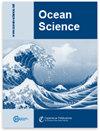对波罗的海两个流域之间影响水交换的强湍流和混合现象的观测
IF 3.3
3区 地球科学
Q2 METEOROLOGY & ATMOSPHERIC SCIENCES
引用次数: 0
摘要
摘要湍流近岸混合对波罗的海盆地之间的河口环流以及当地生态系统都很重要,特别是在富营养化和缺氧条件方面。虽然盆地内部总体上相对平静,但陡峭水深特征上的分层流是众所周知的强湍流混合源。然而,目前的现场观测往往无法捕捉到与粗糙水深上的溢流有关的动态和间歇性湍流混合的时空发展。我们展示了位于奥兰海(连接波罗的海北部和波罗的海两侧)、取样稀少的南夸克(Southern Quark)的一个原型岩床和相邻深海峡的海洋观测数据,以及可公开获取的高分辨率水深测量数据。我们的数据是在 2019 年 2 月至 3 月和 2020 年 3 月两次为期一周的 R/V Electra 巡航中获得的。我们收集了湍流混合的高分辨率宽带声学观测数据、原位微结构剖面测量数据以及声学多普勒海流剖面仪的海流速度数据。我们发现,在陡峭的水深峭壁上的非潮汐分层流在时间上逆转,形成了一个动态的、极富能量的环境。在两次巡航中,观测到的水流在几天的时间尺度内发生了逆转。陡崖南侧较咸、较暖、含氧量较低的深层水部分受阻,反向流有时受水力控制,陡崖两侧出现水力跃迁,表层小尺度空间变化大。与未受溢流直接影响的参照站相比,溢流口附近整个水柱的湍流动能耗散率、垂直湍流扩散率和垂直盐通量率增加了 3-4 个数量级,溢流口附近的平均耗散率介于 10-7 和 10-6 W kg-1 之间,湍流口附近整个水柱的平均垂直扩散率介于 0.001 m2 s-1 和 0.001 m2 s-1 之间,湍流口附近整个水柱的平均湍流动能耗散率介于 10-7 和 10-6 W kg-1 之间,湍流口附近整个水柱的平均垂直扩散率介于 0.卤线内的平均垂直扩散率为 0.001 平方米/秒-1,卤线以下可达 0.1 平方米/秒-1,卤线内的平均垂直盐通量约为 0.01 克/米-2 秒-1,卤线以下为 0.1 至 1 克/米-2 秒-1。根据声学观测和现场测量结果,我们认为造成卤化层混合高度增加的根本原因是在卤化层界面断裂的剪切波和地形利波的共同作用。我们预计,由此产生的南夸克深层和表层水变化会直接影响波罗的海和波罗的海北部之间的交换过程,而且观测到的混合现象可能对波罗的海的氧气和营养物质状况非常重要。本文章由计算机程序翻译,如有差异,请以英文原文为准。
Observations of strong turbulence and mixing impacting water exchange between two basins in the Baltic Sea
Abstract. Turbulent diapycnal mixing is important for the estuarine circulation between basins of the Baltic Sea as well as for its local ecosystems, in particular with regard to eutrophication and anoxic conditions. While the interior of the basins is overall relatively calm, stratified flow over steep bathymetric features is known as a source of strong turbulent mixing. Yet, current in situ observations often cannot capture the spatio-temporal development of dynamic and intermittent turbulent mixing related to overflows over rough bathymetry. We present observational oceanographic data together with openly accessible high-resolution bathymetry from a prototypical sill and an adjacent deep channel in the sparsely sampled Southern Quark located in the Åland Sea, connecting the northern Baltic Proper with the Bothnian Sea. Our data were acquired during two 1-week cruises on R/V Electra in February–March 2019 and 2020. We collected high-resolution broadband acoustic observations of turbulent mixing together with in situ microstructure profiler measurements, and current velocities from acoustic Doppler current profilers. We found that a temporally reversing non-tidal stratified flow over the steep bathymetric sill created a dynamic and extremely energetic environment. The observed flow reversed during both cruises on timescales of a few days. Saltier, warmer, and less oxygenated deep water south of the sill was partly blocked, the reversing flow was at times hydraulically controlled with hydraulic jumps occurring on both sides of the sill, and high spatial variability occurred in the surface layer on small scales. Dissipation rates of turbulent kinetic energy, vertical turbulent diffusivities, and vertical salt flux rates were increased by 3–4 orders of magnitude in the entire water column in the vicinity of the sill compared to reference stations not directly influenced by the overflow with average dissipation rates near the sill between 10−7 and 10−6 W kg−1, average vertical diffusivities of 0.001 m2 s−1 in the halocline and up to 0.1 m2 s−1 below the halocline, and average vertical salt flux rates around 0.01 g m−2 s−1 in the halocline and between 0.1 and 1 g m−2 s−1 below the halocline. We suggest, based on acoustic observations and in situ measurements, that the underlying mechanism for the highly increased mixing across the halocline is a combination of shear and topographic lee waves breaking at the halocline interface. We anticipate that the resulting deep- and surface-water modification in the Southern Quark directly impacts exchange processes between the Bothnian Sea and the northern Baltic Proper and that the observed mixing is likely important for oxygen and nutrient conditions in the Bothnian Sea.
求助全文
通过发布文献求助,成功后即可免费获取论文全文。
去求助
来源期刊

Ocean Science
地学-海洋学
CiteScore
5.90
自引率
6.20%
发文量
78
审稿时长
6-12 weeks
期刊介绍:
Ocean Science (OS) is a not-for-profit international open-access scientific journal dedicated to the publication and discussion of research articles, short communications, and review papers on all aspects of ocean science: experimental, theoretical, and laboratory. The primary objective is to publish a very high-quality scientific journal with free Internet-based access for researchers and other interested people throughout the world.
Electronic submission of articles is used to keep publication costs to a minimum. The costs will be covered by a moderate per-page charge paid by the authors. The peer-review process also makes use of the Internet. It includes an 8-week online discussion period with the original submitted manuscript and all comments. If accepted, the final revised paper will be published online.
Ocean Science covers the following fields: ocean physics (i.e. ocean structure, circulation, tides, and internal waves); ocean chemistry; biological oceanography; air–sea interactions; ocean models – physical, chemical, biological, and biochemical; coastal and shelf edge processes; paleooceanography.
 求助内容:
求助内容: 应助结果提醒方式:
应助结果提醒方式:


